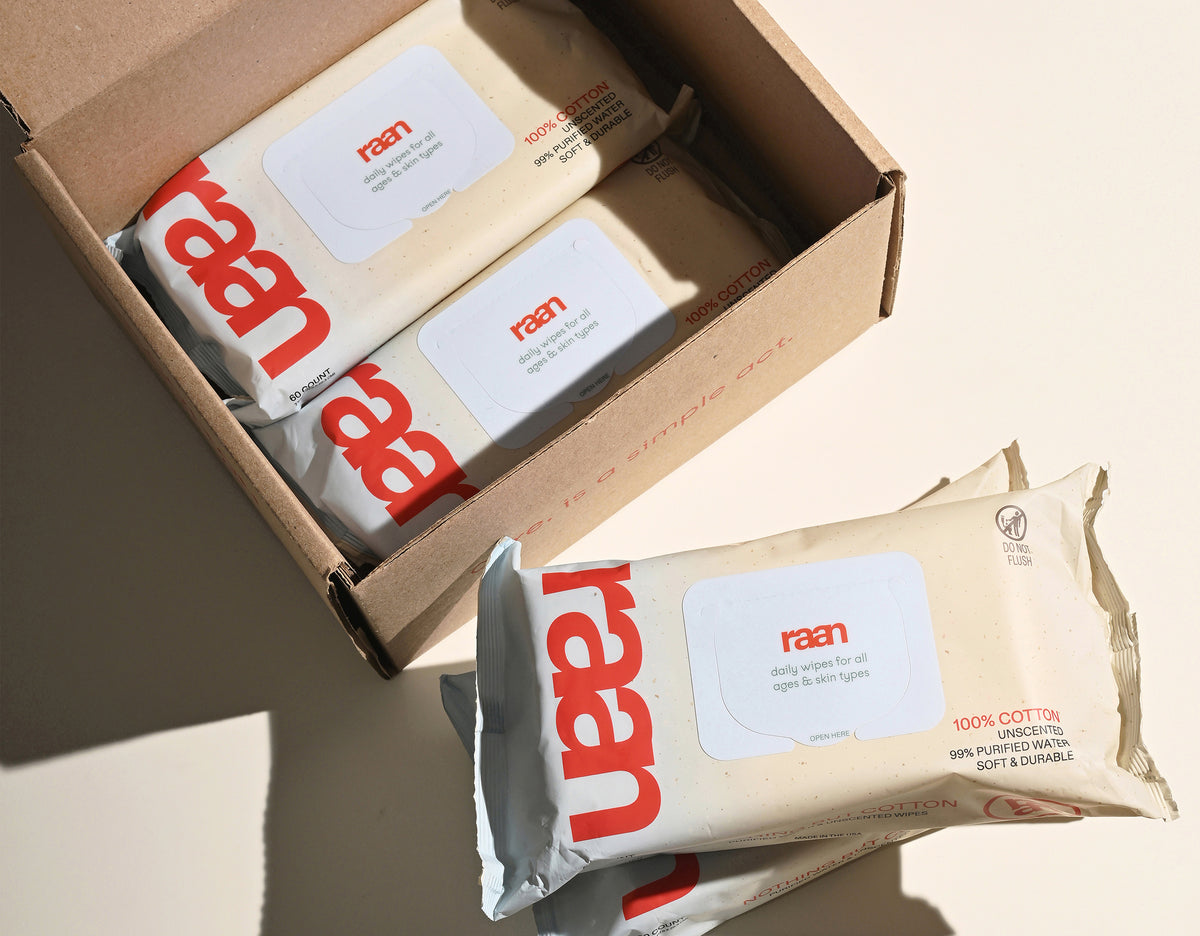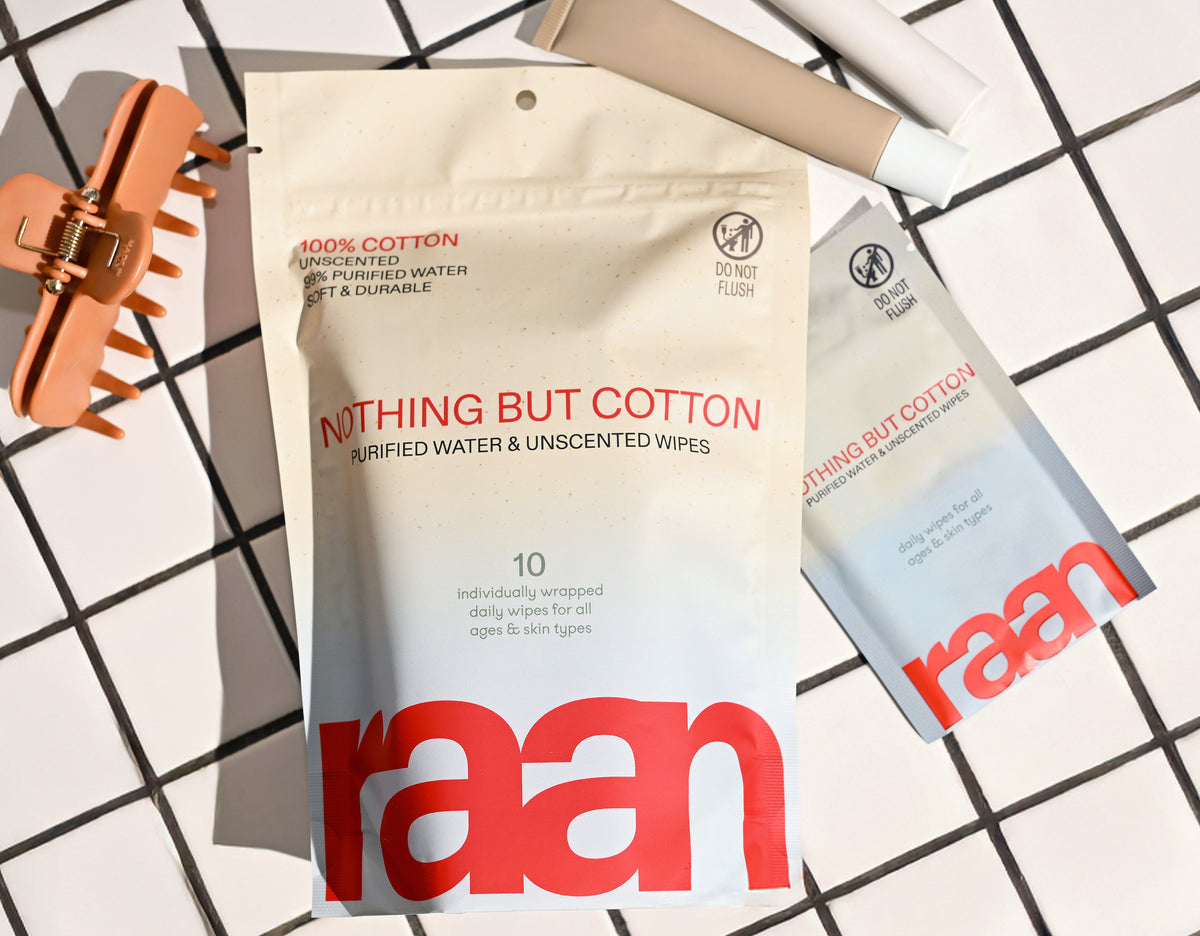Key Takeaways
- Children's skin is up to 20% thinner than adult skin, making it more susceptible to irritation and damage.
- Many families use products meant for adult skin, which may not be suitable for children.
- Effective care of children's skin requires an approach based on transparency and simplicity.
- Choosing skin care products should be guided by scientific evidence rather than marketing claims.
Table of Contents
- Understanding Children's Skin – What Makes It Different
- Building a Safe Daily Skin Care Routine for Kids
- Spotting and Addressing Sensitive Skin Needs
- Managing Common Skin Conditions in Children
- Sun Safety for Delicate Skin – Practical Protection Techniques
- Choosing Safe, Transparent Products – Raan's Approach
- Age-Specific Skin Care – Practical Guides From Infancy to Adolescence
- Teaching Kids Lifelong Skin Health – Habits, Education, & Empowerment
- Everyday, Honest Skin Care – Your Next Step
Care of Children's Skin – An Honest, Practical Guide for Real-Life Families
Children's skin is up to 20% thinner than adult skin, making it significantly more vulnerable to irritation, dryness, and environmental damage. Yet most families navigate this reality with products designed for adult skin or marketing claims that prioritize aspiration over function. The care of children's skin requires a fundamentally different approach, one grounded in transparency, simplicity, and the science of what actually works.
At Raan, we believe clean care should be uncomplicated. After years of decoding misleading "clean" claims, we've learned that truly safe products are rare. Children's delicate skin deserves better than synthetic preservatives, plastic fibers, and vague ingredient lists. This guide cuts through the noise to deliver practical, science-backed strategies for protecting and nurturing your child's skin, from infancy through adolescence.
For families seeking a safer alternative, the only unbleached, 100% cotton baby wipe for sensitive skin offers gentle cleansing without harsh chemicals. If you need a convenient option for on-the-go cleanups, try the unbleached, 100% cotton pocket wipe for sensitive skin, perfect for travel or school bags.
The 3 Essentials of Child Skin Care
- Gentle cleansing: Use fragrance-free, EWG-verified products with minimal ingredients
- Barrier protection: Apply moisturizer within 3 minutes of bathing
- Sun safety: Physical barriers first, mineral sunscreen for exposed areas
Understanding Children's Skin – What Makes It Different
Infant skin absorbs substances up to twice as rapidly as adult skin, creating both opportunity and risk. The stratum corneum, skin's protective barrier, remains underdeveloped until around age 2, leaving children more susceptible to irritants, allergens, and moisture loss. This biological reality explains why products formulated for adults often trigger reactions in children.
Skin needs evolve dramatically across childhood stages. Newborns face diaper rash and cradle cap due to immature oil glands and frequent moisture exposure. Toddlers develop contact sensitivities as they explore environments filled with potential irritants. School-age children encounter new challenges, playground dirt, increased sun exposure, and the beginning of hormonal changes that affect oil production.
| Characteristic | Children's Skin | Adult Skin |
|---|---|---|
| Thickness | 20% thinner | Fully developed |
| pH Level | Higher (less acidic) | 4.5-5.5 (acidic) |
| Absorption Rate | Up to 2x faster | Standard rate |
| Barrier Function | Developing until age 2 | Fully mature |
Understanding these differences transforms how we approach care of children's skin. Less truly is more, gentle formulations with fewer ingredients reduce the risk of sensitization while supporting natural barrier development.
Building a Safe Daily Skin Care Routine for Kids

Effective child skin care centers on timing, technique, and product selection. The golden rule: moisturize within 3 minutes after bathing to trap water in the skin and strengthen the barrier function. This window maximizes hydration while minimizing the need for heavy, potentially irritating formulations.
Morning Routine by Age
- Infants (0-12 months): Gentle wipe-down with unbleached cotton wipes, diaper area care, light moisturizer on dry patches
- Toddlers (1-3 years): Quick face wash with water, full-body moisturizer after bath days, sun protection before outdoor play
- School-age (4-12 years): Independent face washing, targeted moisturizing, daily sunscreen application
Common mistakes include over-cleansing (which strips natural oils), using adult products (too harsh for developing skin), and inconsistent moisturizing. For busy mornings, keep routines simple: a gentle wipe with EWG-verified ingredients handles quick cleanups, while a pump of fragrance-free moisturizer addresses overnight dryness.
The key is establishing patterns that work with real life, not against it. Sensitive skin responds best to consistency, same products, same timing, same gentle approach that respects the skin's natural protective mechanisms.
Spotting and Addressing Sensitive Skin Needs
Sensitive skin affects 20-30% of children ages 0-5, manifesting as persistent redness, dry patches that don't respond to basic moisturizing, or reactions to products that seem gentle. Recognition is the first step toward effective management.
Product selection becomes critical for sensitive skin. Look for food-grade preservatives like sodium benzoate and potassium sorbate instead of synthetic alternatives. Avoid fragrances, dyes, and plastic-based materials that can trigger contact sensitivities. EWG-verified formulations provide an additional layer of safety screening.
Quick-Check List: Signs Your Child's Skin Needs a Gentler Approach
- Redness that persists after removing obvious irritants
- Dry patches that worsen with standard moisturizers
- Reactions to "gentle" or "baby" products
- Increased sensitivity during seasonal changes or illness
Environmental triggers often compound sensitive skin issues. Hard water strips natural oils, requiring more frequent moisturizing with barrier-repairing formulations. Laundry detergents with optical brighteners and synthetic fragrances can cause delayed reactions that appear unrelated to the original source. Switching to fragrance-free, dye-free alternatives often resolves persistent irritation within 7-10 days.
| Safe for Sensitive Skin | Potential Irritants to Avoid |
|---|---|
| Purified water, organic aloe | Fragrance, parfum |
| Food-grade preservatives | Parabens, formaldehyde releasers |
| Unbleached cotton materials | Synthetic fibers, plastic blends |
| EWG-verified ingredients | Unspecified "natural fragrance" |
For more insights on choosing the right wipes, read our guide on best wipes for delicate skin care.
Managing Common Skin Conditions in Children
Eczema, diaper rash, and minor irritation stem from barrier dysfunction, when skin can't retain moisture or protect against environmental irritants. Genetics load the gun, but environmental factors pull the trigger. Understanding this relationship helps parents address root causes rather than just symptoms.
Daily management focuses on barrier repair and trigger avoidance. For eczema, apply fragrance-free moisturizer twice daily using the "wet skin" method, smooth over slightly damp skin to enhance absorption. Keep fingernails short to minimize scratch damage, and choose breathable fabrics like cotton over synthetic blends that trap heat and moisture.
Diaper rash requires a different approach: frequent changes every 2 hours, gentle cleansing with unbleached cotton wipes, and allowing air-dry time before reapplying barriers. The goal is reducing contact time with irritants while supporting natural healing processes.
Seek dermatological consultation when rashes persist beyond 5 days, worsen despite gentle care, or are accompanied by fever, weeping, or signs of infection. Early professional intervention prevents minor issues from becoming chronic conditions that affect quality of life and sleep patterns.
For a complete breakdown of the benefits of unbleached cotton, see our article on unbleached cotton.
Sun Safety for Delicate Skin – Practical Protection Techniques

Eighty percent of lifetime sun exposure occurs before age 18, making childhood sun protection a critical investment in long-term skin health. Children's thinner skin burns faster and more severely than adult skin, requiring proactive rather than reactive approaches.
Physical barriers provide the most reliable protection: wide-brimmed hats, UPF-rated clothing, and stroller canopies create shade without chemical exposure. For babies under 6 months, these methods are preferred over sunscreen, which can irritate immature skin barriers.
When sunscreen becomes necessary, mineral-based formulations with zinc oxide or titanium dioxide offer broad-spectrum protection without absorption concerns. Apply 15 minutes before sun exposure, reapply every 2 hours, and increase frequency to every 40 minutes during swimming or active play. Set phone reminders, reapplication is where most sun protection fails.
Timing matters as much as products. Avoid peak UV hours between 10 AM and 4 PM when possible. When outdoor activities are unavoidable during these times, combine multiple protection strategies: shade, clothing, and appropriate sunscreen for exposed areas like face and hands.
For more tips on sun protection, check out our blog post on sunscreen for sensitive skin.
Choosing Safe, Transparent Products – Raan's Approach
True transparency in care of children's skin means knowing exactly what touches their delicate barrier, no vague terms, no hidden ingredients, no compromises on safety. Most conventional products rely on synthetic preservatives, plastic fibers, and fragrance systems that create more problems than they solve.
Raan wipes represent a fundamentally different philosophy: unbleached, 100% cotton material paired with just five EWG-verified ingredients. Our formula includes purified water, food-grade preservatives (sodium benzoate and potassium sorbate), ethylhexylglycerin for skin conditioning, organic aloe for moisture, and citric acid for pH balance. No plastic fibers, no synthetic fragrances, no bleaching chemicals.
| Feature | Raan Wipes | Conventional Wipes |
|---|---|---|
| Material | Unbleached, 100% cotton | Plastic-blend nonwoven |
| Preservatives | Food-grade only | Synthetic preservative systems |
| Certifications | EWG Verified, Natural Cotton | Limited or none |
| Packaging Impact | 70% less plastic, 35% recycled | Hard plastic dispensers |
Our certifications tell the story: EWG Verified means every ingredient meets their strictest safety standards. Natural Cotton Seal confirms our material is genuinely cotton, not synthetic blends. Women Owned and Cruelty Free reflect our values in action.
If you're looking for a complete solution for busy families, explore the mess-ready pack for all your cleanup needs.
Age-Specific Skin Care – Practical Guides From Infancy to Adolescence
Children's skin needs evolve dramatically from birth through the teen years. Here's how to adapt your approach for each stage.
Infants (0-12 months)
Best practices: Gentle cleansing with plain water or unbleached cotton wipes, barrier protection for diaper area, minimal products.
Bathe every 2-3 days using lukewarm water. For diaper changes, use cotton wipes with food-grade preservatives, they're safe enough for the most delicate skin. Apply a thin layer of zinc oxide cream if redness appears.
Key timing: Moisturize within three minutes after bathing while skin is still damp.
Toddlers (1-3 years)
New additions: Daily moisturizing, supervised handwashing, introduction of SPF 30+ sunscreen.
This stage brings playground dirt and food messes. Keep EWG Verified wipes handy for quick cleanups, they work on faces, hands, and sticky surfaces without harsh chemicals. Start teaching handwashing with gentle, fragrance-free soap.
Begin sun protection habits: apply mineral sunscreen 15 minutes before outdoor play, reapply every two hours.
School-age (4-11 years)
Growing independence: Self-directed washing, consistent sun care, addressing minor scrapes and dry patches.
Children this age can manage basic routines with guidance. Pack travel-sized wipes for school cleanups, look for plastic-free options that won't irritate sensitive skin. Establish morning and evening routines they can follow independently.
Common needs: Extra moisturizing during winter months, treating minor cuts with gentle cleansing.
Teens (12+ years)
Hormonal changes: Oil production increases, acne may develop, routine becomes more complex.
Introduce gentle cleansing twice daily, avoid harsh scrubs that can worsen breakouts. Teens still benefit from simple, transparent products. If acne develops, add a mild salicylic acid treatment gradually.
The best skin care products for 12 year olds remain gentle and fragrance-free. Avoid the temptation to use adult-strength formulas that can irritate developing skin.
Transition tip: When moving between age stages, introduce new products one at a time. This helps identify any sensitivities and prevents overwhelming young skin.
If you're just starting out, the starter set is a practical way to cover all the basics for your child's skin care routine.
Teaching Kids Lifelong Skin Health – Habits, Education, & Empowerment

Building healthy skin habits early creates lasting benefits. The goal isn't perfection, it's consistency and understanding.
Make it routine, not a chore: Pair skin care with existing habits. Apply sunscreen while packing the beach bag. Use wipes for post-playground cleanup. Keep moisturizer next to the toothbrush.
Age-appropriate education: Explain why we protect our skin without creating fear. "Sunscreen helps our skin stay healthy" works better than warnings about skin damage. For older kids, discuss how gentle products support their skin's natural protective barrier.
Tools that help: Visual reminders work well, a chart showing when to apply sunscreen, or a basket of approved products they can choose from. Let them pick between two gentle options to build decision-making skills.
Gender-neutral approach: Skin health isn't about appearance, it's about comfort and protection. Boys and girls both benefit from proper care of children's skin, regardless of cultural messages they might receive elsewhere.
Children who learn these habits early carry them into adulthood. They understand ingredient labels, recognize their skin's needs, and make informed choices. That's the real goal: raising humans who can care for themselves with confidence and knowledge.
Everyday, Honest Skin Care – Your Next Step
Effective care of children's skin doesn't require complicated routines or expensive products. It requires understanding, consistency, and transparency in what we choose.
The science is clear: children's skin thrives with gentle, minimal intervention. Look for products with full ingredient disclosure, avoid unnecessary additives, and trust your observations of your child's skin.
Ready to start? Three steps for better child skin care today:
- Audit current products, read every ingredient label
- Establish age-appropriate daily routines
- Choose transparent, EWG Verified options for cleanups and care
Clean care isn't an aspiration, it's an everyday, attainable solution for families who want better. Your children's skin deserves products made with the same care you'd use in your own kitchen: simple, safe, and honest about what's inside.
For more information on newborn skin care, visit the NHS guide to baby skincare.
Frequently Asked Questions
Why is children's skin more vulnerable to irritation and damage compared to adult skin?
Children's skin is up to 20% thinner than adult skin, which means it has a less developed protective barrier. This makes it more prone to irritation, dryness, and quicker absorption of substances, increasing the risk of damage from harsh ingredients or environmental factors.
What are the key components of a safe and effective daily skin care routine for children?
A safe routine includes gentle cleansing with fragrance-free, EWG-verified products that have minimal ingredients, applying moisturizer within three minutes after bathing to protect the skin barrier, and daily sun protection using physical barriers and mineral-based sunscreen on exposed areas.
How can parents identify and manage common skin conditions or sensitivities in their children?
Parents should watch for signs like redness, dryness, or unusual reactions after using products. Managing sensitivities involves switching to hypoallergenic, fragrance-free products, maintaining gentle cleansing, and consulting a healthcare provider if conditions persist or worsen.
What criteria should be used to choose skin care products that are truly safe and suitable for children's delicate skin?
Choose products with transparent, minimal ingredient lists verified by trusted sources like EWG, free from synthetic preservatives, fragrances, plastic fibers, and bleach. Prioritize unbleached, natural materials like 100% cotton and formulas designed specifically for sensitive skin to ensure safety and function.






